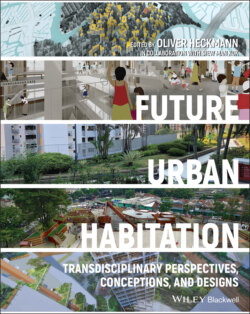Читать книгу Future Urban Habitation - Группа авторов - Страница 37
Singapore: A City of Social Relations
ОглавлениеMy collaborators and I wanted to better understand the personal communities of Singaporeans and did so by asking our respondents to name their contacts in response to a list of different scenarios, for example, ‘With whom have you discussed important matters?’ and ‘From whom have you borrowed money?’
The study elicited 17 000 names from 3000 respondents, with the average network size about six names. Of the 17 000 ties, the majority were friendship ties (45%) and family ties (34%). Co‐workers represented 15%. Notably, neighbours comprised only 6% of all ties, underscoring the point I made earlier about communities being personal and stretching beyond the neighbourhood. Indeed, while much discussion revolves around life in neighbourhoods (e.g. for work on gentrification, see Lees et al. 2013; Smith and Williams 2013), my study suggests today's relationships go far beyond neighbourhoods.
In our study, we paid special attention to the extent to which ties bridge social divides; this was our measure of inclusivity. We focused on network diversity: the extent to which respondents were able to name contacts with a variety of characteristics and backgrounds. For example, gender network diversity measured the extent to which respondents were able to name male and female contacts. Racial/ethnic network diversity measured the extent to which they were able to name contacts from the four Singaporean ethnic groups. The scores, known as ‘indices of qualitative variation’ (IQV) (Knoke and Yang 2008), ranged from 0 to 1, 0 for the absence of contact diversity (on whichever attribute), and 1 for a completely diverse set of contacts. A network of six, with three male and three female contacts would be a perfectly balanced network on the attribute of gender and have a gender IQV score of 1.
The results were unexpected. As Singaporeans socialized into the ethos of our society, including its discourses, we had expected to see the usual ‘fault lines’ of race and religion as the most pertinent social divisions. But this was not the case.
The median network diversity scores on race and religion were sizeable – 0.37 and 0.47 respectively. The network diversity scores on gender and age were also substantial – 0.75 and 0.67 respectively. To our surprise, the largest divides were class‐based. The median diversity scores for ‘elite’ diversity and ‘housing’ diversity were both 0 (Table 2.1). The scores suggested that the middle person, the average person, had a network that was not at all diverse with respect to contacts with different schooling and housing backgrounds. The typical network was a closed one on both counts.
To illustrate this more intuitively, consider the dyads that connect egos (respondents) and alters (network members). Table 2.2 shows a close correspondence between ego and alter characteristics. Public housing respondents frequently named other public housing residents as contacts; private housing respondents frequently named other private housing residents as contacts. Diverse ties (i.e. those between the different housing types) occurred less often.
We observed the same pattern for schooling. Table 2.3 shows respondents from elite school backgrounds naming contacts from elite school backgrounds. By the same token, respondents from non‐elite school backgrounds named contacts from non‐elite school backgrounds. Again, diverse ties (i.e. between elites and non‐elites) occurred much less often.
Table 2.1 Network diversity scores based on IQV measures.
| Network diversity | Mean | Median |
|---|---|---|
| Gender IQV (male vs. female) | 0.66 | 0.75 |
| Age IQV (using 6 age categories)a | 0.58 | 0.67 |
| Nationality IQV (Singaporean vs. non‐Singaporean) | 0.37 | 0.36 |
| Race IQV (Chinese, Malay, Indian, Others) | 0.32 | 0.37 |
| Race IQV (Majority – ‘C’ vs. Minority – ‘MIO’) | 0.41 | 0.44 |
| Educational IQV (graduate vs. non‐graduate) | 0.41 | 0.40 |
| Educational IQV (low, middle, high)b | 0.46 | 0.56 |
| Elite IQV (attended an elite school vs. not) | 0.24 | 0 |
| Housing IQV (public vs. private) | 0.37 | 0 |
| Housing IQV (using 4 housing categories)c | 0.54 | 0.64 |
| Tie strength IQV (strong tie vs. weak tie) | 0.48 | 0.60 |
| Spatial IQV (nearby vs. further) | 0.63 | 0.75 |
| Religion IQV (using 8 categories)d | 0.41 | 0.47 |
a Age diversity: Below 30/30 to 39/40 to 49/50 to 59/60 to 69/70 and above.
b Educational diversity using three categories: Low = Primary and below, Secondary, ITE, Pre‐U; Middle = Polytechnic, Professional qualification; High = University degree and above.
c Housing diversity: HDB 1‐ to 3‐room/HDB 4‐room/HDB 5‐room, HDB maisonette/private or condominium apartment or landed property or shophouse.
d Religious diversity: Buddhism/Christianity/Hinduism/Islam/Taoism/Sikhism/Other/No religion.
Table 2.2 Combinations of housing dyads.
| Housing combinations | ||
|---|---|---|
| Ego lives in… | Alter lives in… | Number of ties from ego to alter |
| Public housing | Public housing | 4.3 |
| Private housing | Private housing | 3.1 |
| Private housing | Public housing | 2.6 |
| Public housing | Private housing | 0.8 |
Table 2.3 Combinations of schooling status dyads.
| Schooling combinations | ||
|---|---|---|
| Ego has attended… | Alter has attended… | Number of ties from ego to alter |
| Non‐elite | Non‐elite | 3.9 |
| Elite | Elite | 2.7 |
| Elite | Non‐elite | 2.1 |
| Non‐elite | Elite | 0.4 |
